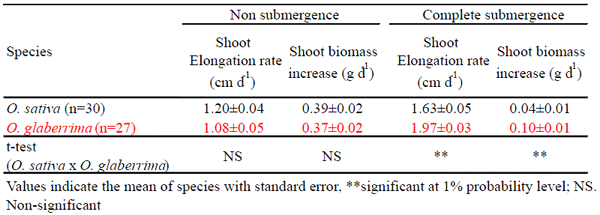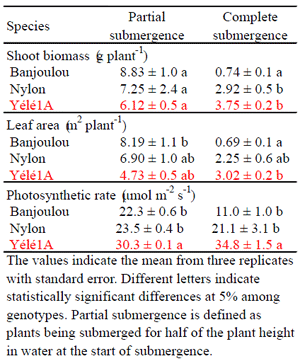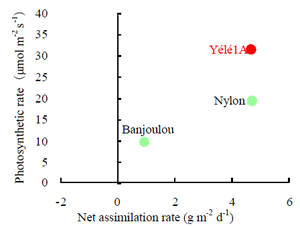Some African rice (Oryza glaberrima Steud.) cultivars survive prolonged complete submergence by shoot elongation
Description
About 90% of rice in sub-Saharan Africa is cultivated without any adequate water management system. The amounts of rainfall do not coincide, and the region is frequently hit every year by either drought or submergence due to flooding. Therefore, the introduction of a rice cultivation system adaptable to this water environment is important for sustainable improvement of the local rice production.
The objective of this study was to develop a rice cultivation technology under flooding condition which occurs frequently in the lowlands of Africa. We aimed to identify the physiological mechanism that reduces submergence stress by testing the cultivation of the African indigenous rice cultivar, Oryza glaberrima Steud. under prolonged complete submergence condition.
A total of 27 genotypes of O. glaberrima and 30 genotypes of O. sativa were tested. The plants were submerged completely for 31 days during their early to middle growth stages in the field. All O. glaberrima cultivars survived, although some of the O. sativa cultivars died during the 31-day submergence. The average rate of increase in shoot biomass and shoot length of the completely submerged O. glaberrima genotypes was faster than that of O. sativa (P<0.01) (Table 1).
Submergence tolerance means the trait of certain plants to be able to reduce the damage and maintain their growth despite prolonged submergence. The typical deepwater cultivars Nylon (O. sativa) and Yélé1 A (O. glaberrima) showed high submergence tolerance and these showed greatly increased shoot biomass and leaf area during complete submergence compared with the submergence-sensitive cultivar Banjoulou (O. sativa) in the experiment inside a growth chamber (Table 2). Especially, Yélé1 A showed more increased shoot biomass than Nylon in complete prolonged submergence. The mechanism linked with the superior tolerance of deep-water genotypes to survive prolonged complete submergence appears to be due to their greater photosynthetic capacity as developed by the leaves newly emerging above the floodwater. This mechanism is closely related to the net assimilation rate of leaves during the submergence (Fig. 1).
These results can be applied to the introduction of these cultivars into lowlands in Africa.
Figure, table
-
Table 1. Effect of submergence on shoot elongation and shoot biomass in the field experiment
-
Table 2. Effect of submergence on shoot biomass, leaf area and photosynthesis 37 days after submergence
-
Fig.1 Relationship between net assimilation rate during submergence and photosynthetic rate after 37 d submergence in a pot experiment
- Affiliation
-
Japan International Research Center for Agricultural Sciences Crop Production and Environment Division
- Classification
-
Administration B
- Term of research
-
FY2008(FY2006~2008)
- Responsible researcher
-
SAKAGAMI Jun-Ichi ( Crop Production and Environment Division )
JOHO Yukiko ( Crop Production and Environment Division )
BOUROUNO Nestor ( Institut de Recherche Agronomique de Guinée )
- ほか
- Publication, etc.
-
Sakagami et al. (2009) Annals of Botany 103:171-180.
- Japanese PDF



